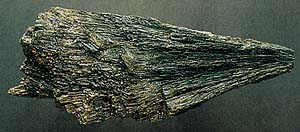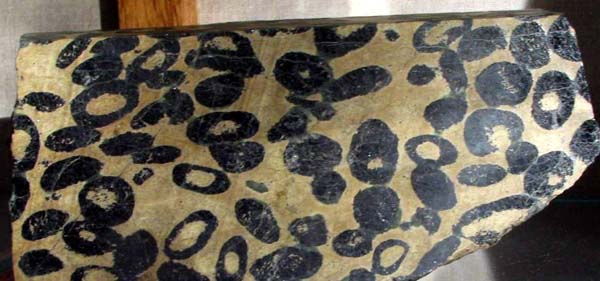Stone, minerals and semiprecious of the world stone
Chlorites (silicates): Serpentine -->rus
 Diagnostic cart.
Diagnostic cart.
On a photo - fibres of Serpentine - asbestos (salamander wool). Down: standard of berthierite.
Mg6 (OH)8 Si4 O10
Crystal structure monoclinic
Hardness on the Mohs scale 2,5-4
Specific unit weight mass 2,5-2,6
Cleavage not clear
Fracture, break padman
Colors colourless, polycoloured (multicoloured)
Colors in powder triturate white
Glance (glitter, glare) from fat to silky
Serpentine - be found as dense aggregates, consisting of cryptocrystalline mass, composes rocks (serpentinite, or Ophite). Crystal structure monoclinic, forms microcrystalline aggregates only. In nature present three main structural forms: antigorite, or foliated serpentine (tints yellow to chlor, dim or with silky brilliance), lisardite, or dense serpentine, and chrysotile, or fibred serpentine (gold yellow with a silk ebb). Places of distribution: Fikhtel (Germany), Karintiya (Austria), Switzerland, Ural (CIS), Canada.
Marine skin, or sepiolite is a product of weathering of serpentine. Hardness on the Mohs scale 2. Closeness 2 (from large porosity less 1). Glance (glitter, glare) dim. Colors white. A line is white. Used for making of cannon-bits and tubes. One of the most known deposits - Eskishekhir (Turkey). A dark green or brown mineral with a greasy or silky lustre, found in igneous and metamorphic rocks. It is used as an ornamental stone; and one variety (chrysotile) is known as asbestos. Composition: hydrated magnesium silicate. Formula: Mg3Si2O5(OH)4. Crystal structure: monoclinic.
The minerals of group of serpentine on composition and optical properties are similar with chlorites, but differ from them a structure. Among them there are two varieties - antigorite and chrysotile. The external type of mineral and his physical and chemical properties strongly vary. There is a lot of varieties, having the independent names, for example antigorite (fissile) and chrysotile (fibred). Fine-fibrous, fine-filamented chrysotiles name an earth-flax, asbestos, salamander wool, no fire in flame.
An asbestos is a collective term for denotation of thin-fibrous minerals of group of serpentine and amphiboles. To amphiboles asbestos add anthophyllite, glaucophane. crocidolite; it is presented an actinolite and tremolite. A heat-resistant chrysotile-asbestos has a most value. It fissions on the thinnest fibres, applied for making of heat-resistant and acidproof tissues. Voylokopodobnye miners name the aggregates of asbestos mountain flax. Places of distribution: The CIS, Canada, south of Africa.
Antigorit is presented wrong plates chlorine, light bluish (cyan) -green, sage-green and white colouring, incorporated in scaly, enough dense aggregates. Their brilliance - mother-of-pear nacreous or resinous.
A chrysotile is observed as aggregates of light-yellow, grey-green or white color, consisting of rough flexible fibres, having silky brilliance. When these fibres unite in the long soft filaments of light-gray color, thin and very tender, they are named an asbestos, or Serpentine - asbestos (salamander wool).
Serpentine is a group near on composition and structure of minerals. Green, dark, black-green, yellow, gold, spotted (as a hide of snake) color. Chemical composition (chemistry, compound) Oxide of magnesium (MGO) 43,0%, silex (SiO2) 44,1%, water (N2o) 12,9%; the oxides of iron and nickel are often present as an admixture. Form of crystals. Fibred (chrysotile), fissile (antigorite). Crystalline structure. Stratified. Class of symmetry. Prismatic - 2/t. Cleavage. A mineral is fibred, at fissile antigorite perfect absolute cleavage. Aggregates. Dense.
Known from carpentry stone in the group of serpentine there is apple-green bowenite with uneven dispersion, dissemination of shallow black spots. Now and then be found almost transparent Williamsite, pierced the black including. Green granular limestone, marble rocks, presenting accretions of serpentine with a marble (for example, connemare marble, verdeantic), have the general point-of-sale name "serpentinite" quite often. They are used as finishing material is in an interior. Deposit minefield mine field occurrence subsoil of similar rocks is in many countries. Entangling serpentinite and ofiecalcites is possible with jade, by a marble onyx and now and then - with turquoise. The product of change of chrome-bearing serpentinite with the rose colouring (to purple) is named stichtite. It be found in Algeria, Republic of South Africa, Tasmania. A bastite is name pseudomorphosis of serpentine on a bronzite. For a mineral silky brilliance is characteristic.
 Diagnostic indication.
Diagnostic indication.
Antigorit is added the action effects of acids. Placed in flame of candle, it hardly fuse on edges. A chrysotile decomposes in muriatic acid, forming the thin fibres of silica. Serpentine melt fuse hardly, in the closed glass kimberlite tube selects plenty of crystallizational water. A behavior is in acids. Dissolves in muriatic and sulphuric acids.
Origin provenance genesis.
Antigorit in nature very widely widespread. As rockforming mineral it be found in serpentinite, to the metamorphic ultrabasic rock, to appearing at the change of peridotite rocks. A chrysotile be found in serpentinite together with antigorite, with which it executes cracks jointly, forming the thick interlacing of fibres (sometimes in in a few ten of centimetres thick), disposed parallell to the walls of cracks (and sometimes athwart or under a corner).
Deposit minefield mine and use.
Classic location of antigorite - Val-Antigorio (Ossola). More large deposits of chrysotile are timed to the paleozoic serpentinite rocks in a province Quebec in Canada. Less large deposits are developed in the USA, Russia, Zimbabwe and on an island Cyprus. In Italy a chrysotile is in many places in Alps, but only in some from them it can be obtained in industrial scales.
Varieties.
There is berthierite in some iron-ore deposits of sedimentary origin, member of group of serpentine, containing iron, both bivalent and trivalent, partly deputized a manganese.

Chrompicotite in serpentinite. Ipyakskiy, Azerbaijan, CIS. A photo: © A.A. Evseev.
